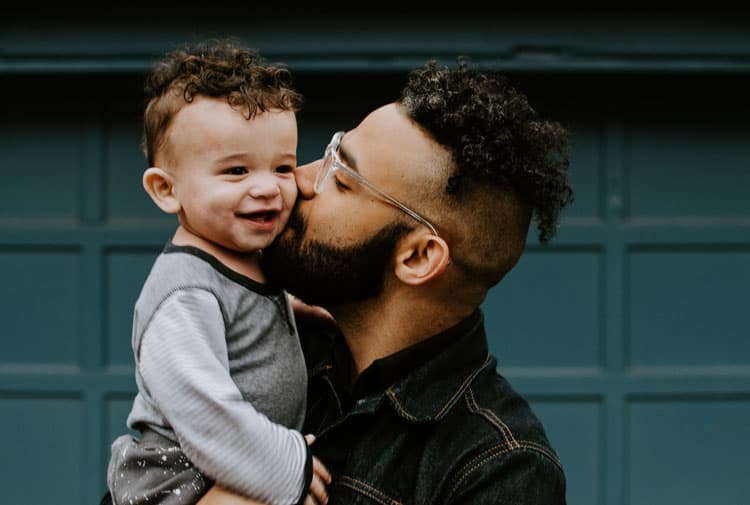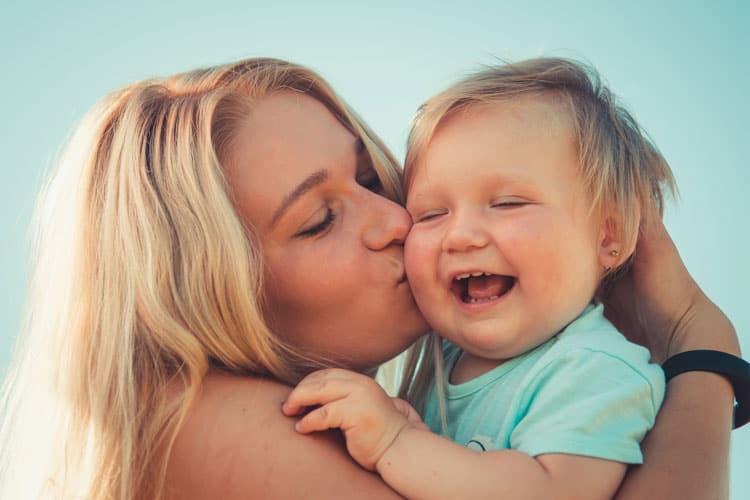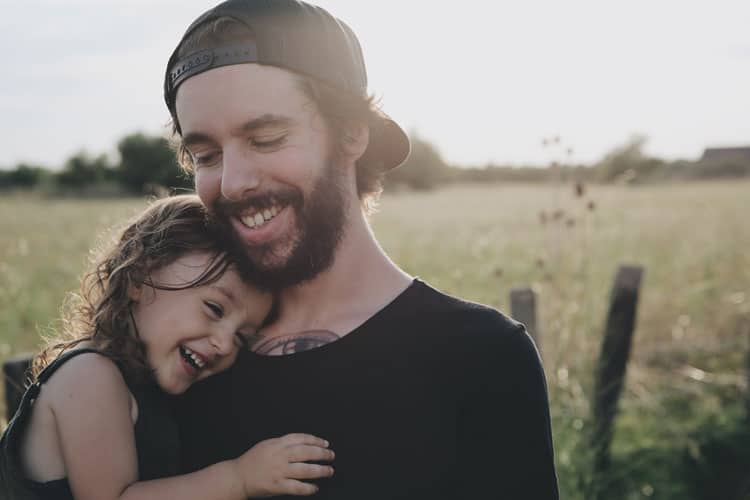The pioneering psychotherapist and author Virginia Satir spent her career studying relationships and communication. In 1959, she helped establish the Mental Research Institute in Palo Alto, California. She and her staff would go on to develop the first training series designed specifically to teach family therapy techniques. Satir’s work is famous in the family therapy field, but her “hug quote” is well-known outside of therapy and explains the power of hugs.
Thirty years after Satir’s death, research continues to demonstrate the impact hugs have on our physical, mental, and emotional well-being. Any parents reading this will be happy to learn that all the time you spend embracing your kiddos is time well spent.
Check out these eight hugging superpowers and share them with your family and kids, PLUS, how to easily implement more hugs into your daily routine!
1. Hugging lowers blood pressure and stress.
Hugs trigger the release of oxytocin, a hormone associated with intimacy and bonding. Since the early 1900s, doctors have recognized the critical role this hormone plays in childbirth and lactation. More recent research has revealed the effect oxytocin has on the central nervous system and cardiovascular system. Oxytocin can reduce blood pressure and lower levels of cortisol, a hormone associated with stress.
Takeaway: Embracing can help reduce anxiety and improve sleep.
2. The power of hugs actually helps turn a bad day around.
A study published in 2018 concluded that a warm embrace can increase positive feelings and reduce negative ones on days when people experience relationship problems. Researchers conducted interviews with 404 participants and concluded that “hugs buffer against deleterious changes in effect associated with experiencing interpersonal conflict.”
Takeaway: Hugs can mitigate the effects of interpersonal conflict.
In the mid-1990s, neurobiologist Mary Carlson and psychiatrist Felton Earls studied children in Romania who grew up neglected in understaffed orphanages. The child-to-caregiver ratio in these institutions was twenty to one, meaning most infants experienced severe sensory deprivation in their formative months.
Through saliva samples, Carlson and Earls found elevated cortisol levels in the infants who were starved of touch and attention. The researchers concluded that a lack of touch and attention stunted the orphans’ growth and adversely affected behavior into adulthood. The work of Carlson and Earls highlights the importance of touch and the power of hugs during the critical development years of birth through three.
Takeaway: Embrace your children as much as possible!
Related articles:
- Three Effective Ways to Instill Gratitude in Your Children
- How To Prepare Your Child For Kindergarten
- How To Be A Good Parent
4. Hugs protect against stress and infection.
Hugs have a “stress-buffering effect.” In a study conducted at the University of Pittsburgh, participants were interviewed about how frequently they experienced conflict and received hugs. One group of participants was then exposed to a virus and monitored to evaluate signs of illness. Those participants who had strong social support and/or physically embraced each other frequently (with the power of hugs) were less likely to get sick.
Takeaway: Twelve hugs a day, keeps the doctor away.
5. Hugging benefits the giver and receiver.
It takes two or more to hug it out. Often, we embrace or hold our children when they’re in need of comfort. But it turns out, this little act of love can also offer stress-reducing benefits for the giver. In a 2012 study, researchers concluded that comforting touch, like hugs, “may be beneficial not only for the receiver but also for the giver.”
Takeaway: Hugs offer reciprocal benefits.
6. Hugging can help stop tantrums.

Tantrums can occur in all ages of children. A tantrum in a toddler may look very different than that of a 12-year-old. However, no matter the age, a hug may be just what they need. Many parents worry that hugging a tantrum-throwing child is rewarding bad behavior with attention. But it is not. Hugging a child is not the same as giving in (which does encourage bad behavior).
Hugging without giving in is helping a child learn to self-regulate and self-regulation is central to success in life. Self-regulation is being able to manage feelings so they don’t intrude heavily on relationships or day-to-day life. This may involve being able to resist ‘losing it’ in upsetting or frustrating situations or being able to calm down when big feelings start to take over.
When children are able to regulate their emotional responses, they become less vulnerable to the ongoing impact of stress. They are also more likely to have the emotional resources to maintain healthy friendships, and the capacity to focus and learn. Research has found that the ability to self-regulate is a strong predictor of academic success…thanks to the power of hugs!
Takeaway: Hugging a tantruming child teaches them to self-regulate!
7. Hugs say “You are accepted.”

Hugging helps create an environment where the person feels whole and accepted. The simple touch of a hug has great health benefits and helps support developmental growth. As children begin to learn about how things work, they need the loving gestures of their parents to feel emotionally secure. They need to be assured that they are accepted into the family.
The nurturing touch of a hug helps to establish trust and a sense of safety in them. It allows them to take in the sights and sounds of the world around them without worry. With a deep sense of security, hugging also leads to an openness to learn new things. It promotes open and honest communication between parent and child.
Takeaway: Hugging helps build trust and safety.
8. Hugging helps develop empathy.

When hugging a child, you are teaching them how to comfort and be comforted. When they recognize someone else needing to be comforted, they will reflect back to how they were taught to show love and comfort. You connect with how both of you are feeling on an emotional and physiological level. With this exchange, hugging teaches your child the value of empathy.
Parents see this development in their children when their child hugs them when they see the parent is sad or upset. This happens as he/she develops an understanding of how you might be feeling. In addition, hugging also teaches your child that love is a two-way street and that they can show love to others.
Takeaway: Children can develop empathy through hugging.
Simple ways to implement the power of hugs with your child:

- Start the day off by hugging your child before you head out for your busy day.
- Say goodbye with a hug when dropping your child off at school.
- When you greet your child from a long day or when they come home from school, greet them with a hug. And tell them you are happy to see them!
- Watch a family movie together and snuggle and hug with a blanket.
- Seek out playtime with them and throughout your play hug them and tickle them.
- Whenever your child shares excitement about something they did, reinforce their self-esteem by giving them a hug and telling them how proud you are.
- Say daily affirmations to your child while giving them hugs.
- Always hug your child goodnight.
Summary
Hugs are a powerful form of nonverbal communication. For little ones, touch isn’t just reassuring and calming, it’s also crucial for development. All those hours parents spend rocking a baby is time well spent. A warm embrace is an investment in a child’s future—a comforting thought for new parents!
But embracing isn’t just important for little ones. Humans thrive in emotionally, mentally, and physically supportive environments—and hugs are an important and universal sign of support. They teach us how to give and receive. They are a tactile example of how love flows both ways.

Kathy is a freelance writer, an Independent Quality Provider with BabyQuip and the mother of a very active one-year-old boy. When she’s not changing diapers, developing engaging content for clients, or helping families travel with little ones, she enjoys reading, gardening, yoga, and naps.



Awe squeeze. :)
How sweet! To think, something as simple and free as a hug can make such an impact.
I really like it when folks get together and share opinions.
Great website, continue the good work!
Aww, this is heartwarming.
Greetings! Very helpful advice in this particular article!
It is the little changes that will make the largest impact.
Many thanks for sharing!
Oh my goodness! Incredible article!
Hi, i foud this article very useful.
It is well written and has helped me a lot.
I love that you wrote about hugging. It’s so important and not many people realize it.
My mom taught me when I was little that humans need 8 hugs per day. It seems like a lot but I’m trying to carry on the tradition with my kids.
Thіs information is priceless.
How can hugs not be great for you. It simply feels so good!
This is really a great and useful piece of information. I’m satisfied that you shared this helpful information with us. Thank you for sharing.
I wonder–is there a certain amount of time where these benefits happen during a hug, or is it even for brief hugs?